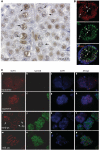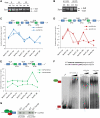Sam68 marks the transcriptionally active stages of spermatogenesis and modulates alternative splicing in male germ cells
- PMID: 21355037
- PMCID: PMC3130265
- DOI: 10.1093/nar/gkr085
Sam68 marks the transcriptionally active stages of spermatogenesis and modulates alternative splicing in male germ cells
Abstract
Sam68 plays an essential role in mouse spermatogenesis and male fertility. Herein, we report an interaction between Sam68 and the phosphorylated forms of the RNA polymerase II (RNAPII) in meiotic spermatocytes. RNase treatment decreased but did not abolish the interaction, consistently with in vitro binding of RNAPII to the Sam68 carboxyl-terminal region. Sam68 retention in the spermatocyte nucleus was dependent on the integrity of cellular RNAs, suggesting that the protein is recruited to transcriptionally active chromatin. Mouse knockout models characterized by stage-specific arrest of spermatogenesis and staining with the phosphorylated form of RNAPII documented that Sam68 expression is confined to the transcriptionally active stages of spermatogenesis. Furthermore, Sam68 associates with splicing regulators in germ cells and we report that alternative splicing of Sgce exon 8 is regulated in a Sam68-dependent manner during spermatogenesis. RNA and chromatin crosslink immunoprecipitation experiments showed that Sam68 binds in vivo to sequences surrounding the intron 7/exon 8 boundary, thereby affecting the recruitment of the phosphorylated RNAPII and of the general splicing factor U2AF65. These results suggest that Sam68 regulates alternative splicing at transcriptionally active sites in differentiating germ cells and provide new insights into the regulation of Sam68 expression during spermatogenesis.
Figures






Similar articles
-
Functional Interaction between U1snRNP and Sam68 Insures Proper 3' End Pre-mRNA Processing during Germ Cell Differentiation.Cell Rep. 2019 Mar 12;26(11):2929-2941.e5. doi: 10.1016/j.celrep.2019.02.058. Cell Rep. 2019. PMID: 30865884
-
The nuclear RNA-binding protein Sam68 translocates to the cytoplasm and associates with the polysomes in mouse spermatocytes.Mol Biol Cell. 2006 Jan;17(1):14-24. doi: 10.1091/mbc.e05-06-0548. Epub 2005 Oct 12. Mol Biol Cell. 2006. PMID: 16221888 Free PMC article.
-
Genotoxic stress causes the accumulation of the splicing regulator Sam68 in nuclear foci of transcriptionally active chromatin.Nucleic Acids Res. 2010 May;38(9):3005-18. doi: 10.1093/nar/gkq004. Epub 2010 Jan 27. Nucleic Acids Res. 2010. PMID: 20110258 Free PMC article.
-
Expression and functions of the star proteins Sam68 and T-STAR in mammalian spermatogenesis.Adv Exp Med Biol. 2010;693:67-81. doi: 10.1007/978-1-4419-7005-3_5. Adv Exp Med Biol. 2010. PMID: 21189686 Review.
-
Sam68: a new STAR in the male fertility firmament.J Androl. 2010 Jan-Feb;31(1):66-74. doi: 10.2164/jandrol.109.008136. Epub 2009 Oct 29. J Androl. 2010. PMID: 19875495 Review.
Cited by
-
Sam68 promotes osteogenic differentiation of aortic valvular interstitial cells by TNF-α/STAT3/autophagy axis.J Cell Commun Signal. 2023 Sep;17(3):863-879. doi: 10.1007/s12079-023-00733-2. Epub 2023 Feb 27. J Cell Commun Signal. 2023. PMID: 36847917 Free PMC article.
-
Clinical significance and effect of Sam68 expression in gastric cancer.Oncol Lett. 2018 Apr;15(4):4745-4752. doi: 10.3892/ol.2018.7930. Epub 2018 Feb 2. Oncol Lett. 2018. PMID: 29552114 Free PMC article.
-
Sam68 mediates leptin signaling and action in human granulosa cells: possible role in leptin resistance in PCOS.Endocr Connect. 2020 Jun;9(6):479-488. doi: 10.1530/EC-20-0062. Endocr Connect. 2020. PMID: 32375121 Free PMC article.
-
RNA-Binding Proteins in the Regulation of Adipogenesis and Adipose Function.Cells. 2022 Jul 31;11(15):2357. doi: 10.3390/cells11152357. Cells. 2022. PMID: 35954201 Free PMC article. Review.
-
The RNA binding protein SAM68 transiently localizes in the chromatoid body of male germ cells and influences expression of select microRNAs.PLoS One. 2012;7(6):e39729. doi: 10.1371/journal.pone.0039729. Epub 2012 Jun 22. PLoS One. 2012. PMID: 22745822 Free PMC article.
References
-
- Braun RE. Post-transcriptional control of gene expression during spermatogenesis. Semin. Cell Dev. Biol. 1998;9:483–489. - PubMed
-
- Elliott D. Pathways of post-transcriptional gene regulation in mammalian germ cell development. Cytogenet. Genome Res. 2003;103:210–216. - PubMed
-
- Paronetto MP, Sette C. Role of RNA-binding proteins in mammalian spermatogenesis. Int. J. Androl. 2010;33:2–12. - PubMed
-
- Turner JM, Mahadevaiah SK, Fernandez-Capetillo O, Nussenzweig A, Xu X, Deng CX, Burgoyne PS. Silencing of unsynapsed meiotic chromosomes in the mouse. Nat. Genet. 2005;37:41–47. - PubMed
Publication types
MeSH terms
Substances
Grants and funding
LinkOut - more resources
Full Text Sources
Molecular Biology Databases

